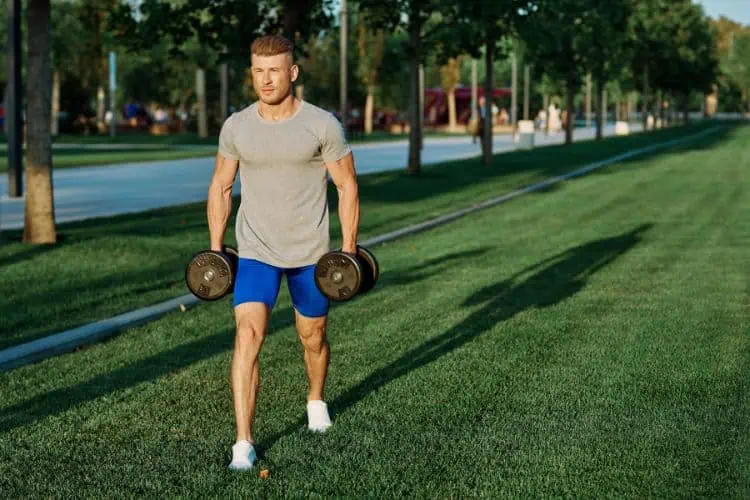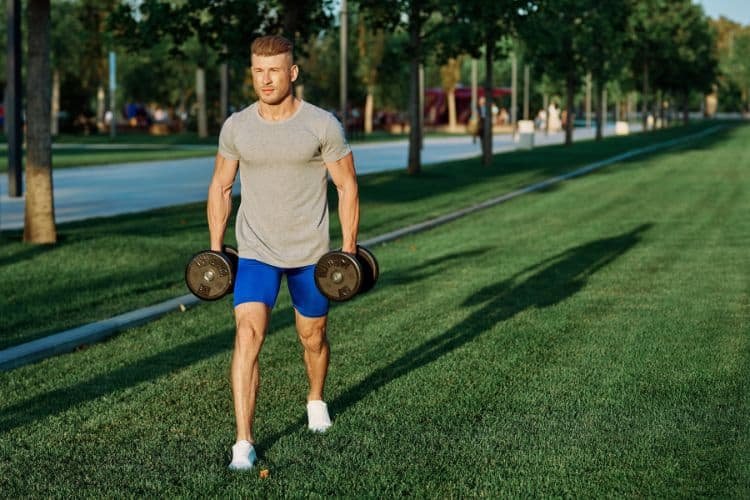
Farmer’s carries are a deceptively simple yet highly effective exercise. They involve picking up heavy weights in each hand and walking a specified distance or for a set period of time. While it might sound straightforward, this workout is a full-body exercise that offers numerous benefits, including improved grip strength, core stability, and cardiovascular conditioning. In this comprehensive guide, we’ll explore everything you need to know about farmers carries workouts, including their benefits, variations, and how to incorporate them into your routine.
What Are Farmers Carries Workouts?
Farmer’s carries, also known as farmer’s walks, are a type of loaded carry exercise. The premise is simple: lift a heavy object in each hand, maintain good posture, and walk for a designated distance or time. Despite their simplicity, farmer’s carries challenge nearly every muscle in the body and are often referred to as a “functional” exercise because they mimic real-life activities like carrying groceries or luggage.
Key Muscles Worked:
- Grip Strength: Forearm muscles and hand strength.
- Core Stability: Abdominals, obliques, and lower back.
- Legs and Glutes: Quads, hamstrings, and gluteus maximus.
- Upper Body: Trapezius, shoulders, and upper back.
Benefits of Farmer’s Carries Workouts
1. Improved Grip Strength
One of the standout benefits of farmer’s carries is the development of grip strength. This is crucial not only for fitness enthusiasts but also for athletes and individuals in manual labor professions. A stronger grip can enhance performance in other lifts, such as deadlifts and pull-ups.
2. Core Stability
Farmer’s carries require maintaining an upright posture while holding heavy weights. This engages the core muscles to stabilize the spine and prevent side-to-side tilting. Over time, this can improve overall core strength and reduce the risk of lower back injuries.
3. Full-Body Conditioning
Since farmer’s carries work multiple muscle groups simultaneously, they provide an efficient full-body workout. This makes them ideal for individuals looking to maximize their workout time.
4. Cardiovascular Benefits
Walking with heavy weights elevates the heart rate, providing a cardiovascular challenge. Over time, this can improve endurance and help burn calories.
5. Functional Strength
Farmer’s carries mimic everyday activities, making them one of the most functional exercises. They help improve balance, coordination, and the ability to handle heavy loads in real-life scenarios.
How to Perform Farmer’s Carries Correctly
Proper form is essential to maximize the benefits of farmer’s carries and reduce the risk of injury. Follow these steps to execute the exercise safely:
- Choose Your Weights Select dumbbells, kettlebells, or farmer’s carry handles with a challenging but manageable weight.
- Pick Up the Weights Stand with your feet shoulder-width apart. Bend at the hips and knees to lift the weights, keeping your back straight and chest up.
- Maintain Good Posture Once standing, ensure your shoulders are pulled back, your chest is lifted, and your core is engaged. Avoid slouching or leaning to one side.
- Walk Steadily Take small, controlled steps. Keep your core tight and breathe steadily throughout the movement. Walk for a set distance (e.g., 20-50 meters) or time (e.g., 30-60 seconds).
- Set the Weights Down Safely After completing your set, bend at the hips and knees to lower the weights to the ground with control.
Variations of Farmer’s Carries
1. Classic Farmer’s Carry
The traditional FC involves holding equal weights in each hand. It’s a great starting point for beginners.
2. Suitcase Carry
Hold a single weight in one hand, like carrying a suitcase. This variation increases the demand on your obliques and improves lateral stability.
3. Overhead Carry
Press the weights overhead and walk. This challenges shoulder stability and core strength.
4. Front Rack Carry
Hold the weights in a front rack position, with the weights resting on your shoulders. This variation engages the core and upper back more intensively.
5. Zercher Carry
Hold the weights in the crook of your elbows. This variation targets the biceps and core while challenging posture.
6. Tandem Carry
Use different weights in each hand. This asymmetry forces your core to work harder to maintain balance.
7. Farmer’s Carry with Obstacles
Walk around cones or other obstacles. This adds an element of agility and coordination.
Programming Farmer’s Carries into Your Workouts
Farmer’s carries can be incorporated into your workout routine in several ways:
1. Warm-Up
Use light weights for FC at the start of your workout to activate your core and warm up your grip.
2. Strength Training
Include farmer’s carries in your strength training sessions by using heavy weights for shorter distances.
3. Conditioning Circuits
Add farmer’s carries to a circuit for a full-body conditioning challenge. For example:
4. Finisher
End your workout with a farmer’s carry finisher. Use moderate weights and walk for maximum distance until failure.
Sample Farmer’s Carry Workouts
Beginner’s Farmer’s Carry Workout
- Warm-Up: 5 minutes of light cardio
- FC: 3 sets of 20 meters with moderate weights
- Suitcase Carry: 3 sets of 20 meters per side
- Cool Down: Stretching
Intermediate Farmer’s Carry Workout
- Warm-Up: Dynamic stretches and light cardio
- Farmer’s Carry: 4 sets of 30 meters with heavy weights
- Front Rack Carry: 3 sets of 20 meters
- Overhead Carry: 3 sets of 15 meters
- Cool Down: Foam rolling and stretching
Advanced Farmer’s Carry Workout
- Warm-Up: 10 minutes of mobility work
- FC: 5 sets of 50 meters with maximal weights
- Suitcase Carry: 4 sets of 30 meters per side
- Zercher Carry: 4 sets of 20 meters
- FC with Obstacles: 3 sets of 40 meters
- Cool Down: Yoga poses and deep stretching
Common Mistakes and How to Avoid Them
1. Slouching
Keep your shoulders back and chest up. A rounded back can lead to injury.
2. Uneven Steps
Walk with small, steady steps to maintain control. Avoid rushing.
3. Choosing the Wrong Weight
Start with weights that challenge you but don’t compromise your form.
4. Neglecting Core Engagement
Actively engage your core throughout the movement to maintain stability.
5. Improper Grip
Hold the weights firmly but not so tight that it causes wrist strain. Use chalk if needed for grip support.
Equipment for Farmer’s Carries
1. Dumbbells
Accessible and versatile, dumbbells are a great option for FC.
2. Kettlebells
Their handle design allows for a secure grip, making kettlebells ideal for this exercise.
3. Farmer’s Carry Handles
Specialized handles allow you to load heavier weights, making them suitable for advanced lifters.
4. Trap Bar
A trap bar provides a balanced grip and allows for heavier carries compared to dumbbells or kettlebells.
5. Sandbags
For an unconventional twist, use sandbags. They’re harder to grip, adding an extra challenge.
Farmer’s carries are a versatile, functional, and effective workout that should be a part of every fitness enthusiast’s routine. Whether you’re a beginner or an advanced athlete, the numerous variations and benefits of this exercise make it suitable for anyone. By incorporating FC into your workouts, you can improve grip strength, core stability, cardiovascular fitness, and overall functional strength. Start experimenting with the different variations and watch your strength and endurance levels soar!

